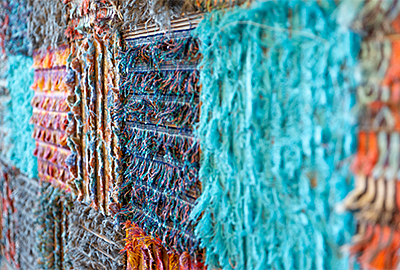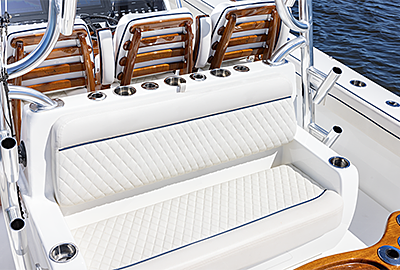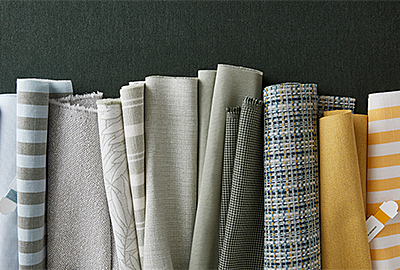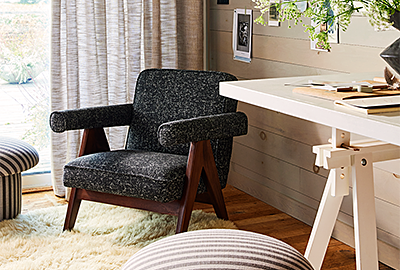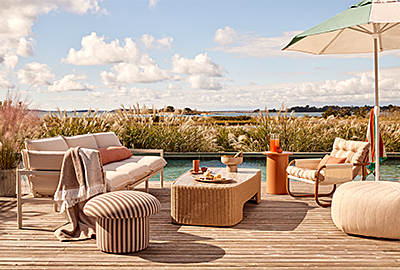For those of us who love crafting, DIY projects, and the ultimate personalization of making our own unique items, Sunbrella is the worry-free choice. Our fabrics are long-lasting, easy to clean, and comfortable for everyone to enjoy in any environment.
All Sunbrella fabrics can be sewn on a regular, domestic sewing machine, although the specifications do vary based on what fabric you are working with.
Many Sunbrella fabrics can now be purchased by the yard on Sunbrella.com. We also partner with a variety of retailers who sell our fabric by the yard. See below for tips and guidelines for sewing with Sunbrella fabrics.


Choosing the Right Sunbrella Fabric
Sunbrella performance fabrics are made from 100% solution-dyed acrylic and feature the core characteristics of being UV, water, mildew and stain resistant. Our fabrics are engineered with Color to the Core™ technology, meaning they are saturated with color and UV-stabilized pigments before they’re spun into yarn, so the pigment goes all the way through the fibers and the color stays true over time.
All Sunbrella fabrics are also easy to clean, even with bleach, and are easy to sew. Sunbrella Marine and Shade fabrics feature a tight weave construction, giving the fabric a slightly stiff feel. This stiffness gives them great dimensional stability, making them perfect for boat covers, home and RV awnings, Bimini tops, patio umbrellas, and more.
Sunbrella upholstery features softer, lighter weaves. These performance fabrics include many different weaves and surface textures, all engineered with softness and durability woven into each fiber. The result is an upholstery fabric that offers long-lasting comfort and durability, perfect for creating comfortable spaces.
While these collections do have a few distinct manufacturing differences, Sunbrella upholstery and the Sunbrella Marine and Shade collections, including Sunbrella Horizon marine vinyl, are expertly coordinated to work together.
Sunbrella Fabric Specs
The majority of Sunbrella fabrics are standard 54” width. Sunbrella Shade and Marine fabrics come in 46” widths with some fabrics available in 60” or 80” widths at the largest size. Browse our fabrics and view the “Technical Information” on a specific fabric’s page to find the width and other helpful information.


Cutting Sunbrella Fabric
You can cut Sunbrella fabrics with typical sewing scissors, a rotary cutter, or pinking shears. The cut edge may unravel a small amount, but this is not an issue if you plan to hem your edges. For a fused edge, use a hot knife (wire or blade) or an ultrasonic cutting instrument. Using a hot knife effectively seals the cut edge of the fabric to prevent unraveling and provides a nice trim edge. Be aware: cutting Sunbrella with a hot knife can sometimes result in sharp edges so be mindful when working not to hurt your fingers.
Under ordinary conditions, Sunbrella fabric will not shrink in the cutting process. Stack cutting is not recommended for fabrics with intricate designs.
For upholstery fabric, patterning, cutting, and sewing should allow for a minimum of a ½ inch seam allowance.
Tips for Sewing with Sunbrella
For stitch length, you always want to sew with the longest stitch length that your sewing machine will allow. For most regular, home sewing machines, the longest stitch length is around 4 millimeters. If you have access to a heavy-duty sewing machine or even an industrial sewing machine, those lengths can range up to around 8 or 10 millimeters. Any of these stitch lengths is fine to use, and the longer the better.
We recommend 7 stitches per inch for upholstery applications, in alignment with Fabric Joint Industry Standards.


Needle and Thread Recommendations for Sunbrella Fabric
Sewing with Sunbrella Upholstery Fabric
For Sunbrella Upholstery fabric, we recommend using a #16-#18 size needle with rounded points to “push” the yarns aside instead of cutting them. Your sewing thread diameter and needle size should be properly matched (100-110 NM thread – Size 16-18 needle).
Solution-dyed bonded polyester thread is the best choice for sewing outdoor fabric projects due to polyester’s high UV resistance and high strength resistance. Nylon thread is better for indoor upholstery projects due to its elasticity.
Sewing with Sunbrella Horizon
For Sunbrella Horizon Marine Vinyl, we recommend using a Round Point (Sharp) #18 size needle with V69 UV Poly or UV Nylon thread.
Sewing with Sunbrella Marine, Shade, Sling, or SeaMark®
For Sunbrella Marine, Shade, Sling, or SeaMark® fabrics, we recommend using a #18 size needle with V69 UV Poly thread. For Shade and Marine fabrics, typically a regular Round Point (R); Round Point, Rounded Tip (RG); or Light Ball Point (FFG) needle would be used.
If when using a Round point you notice that you are puncturing/cutting some of the warp or fill yarns in the fabric, you may consider changing to an RG, FFG or other ball point needle. The ball point will tend to “push” between yarns instead of cutting them.


Additional Sewing Tips
- Lock stitch machines should use the same size bobbin thread as used on top.
- A lock stitch machine with a walking foot is ideal for hemming.
- For joining sewn panels, a double needle stitch is ideal. Needle gauge should be wide, ¾ inch if possible. A chain stitch is preferable in seaming widths of the cloth.
- Maintain tension in front of and behind the needle during the sewing process to minimize puckering/gathering of fabric when seaming.
- Avoid too much back stitching because this technique can weaken the fabric and cause the fabric to tear more easily.
- When patterning, leave extra room for long runs before finishing your ends to make sure needle puckering has not made your item too small.
- Set your stitch tension so the knots are pulled into the material but not pulled to the top of the material, so you don’t create stitch tension puckering. Always lower the tension so the knots show up on the bottom side of the material.
Create with Sunbrella
With Sunbrella fabrics, exceptional comfort and unmatched durability go hand in hand. Shop our fabric selection or find a retailer to get started on your DIY project today!
Make sure to tag us (@Sunbrella) with any finished projects on Instagram, Facebook, Pinterest or wherever you share!




